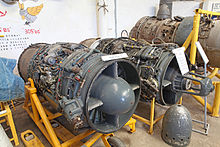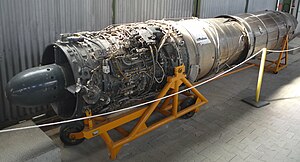|
SNECMA Atar 101
The SNECMA ATAR 101 is a French axial-flow turbojet engine built by SNECMA. It was derived from engines and design work carried out at BMW in Germany during World War II, and extensively developed though a progression of more powerful models. The name is derived from its original design group, Atelier Technique Aéronautique de Rickenbach employing Hermann Östrich and many of the wartime BMW gas turbine design group as well as other German engine design teams.[1] The ATAR 101 powered many of the French post-war jet aircraft, including the Vautour II, Étendard IV, Super Mystère B2, and the Mirage III-001, prototype of the Mirage III series.[2] Design and developmentAt the end of World War II the French aircraft industry was in disarray, having been commandeered by the German government to produce mostly German designed aircraft and aero-engines. To develop an indigenous gas turbine aero-engine the French government acquired the services of a large contingent of German design engineers and technicians. Some of these engineers formed the Atelier Technique Aéronautique de Rickenbach, led by Dr. Hermann Östrich who had been developing gas turbine engines at BMW. By September the team was housed at the Dornier factory at Rickenbach near Lindau on Lake Constance and had largely completed design of the ATAR 101 by October 1945. A contract for development of the engine was awarded in December 1945, a stipulation being that all manufacturing was to be carried out in France.[1] Communications between the ATAR group and SNECMA, the newly formed nationalised engine manufacturer, proved to be difficult and the design team soon moved to Decize on the river Loire, to improve communications with SNECMA and was renamed Aeroplanes G.Voisin, Groupe 'O' . Manufacture of components for the ATAR 101 V1 commenced at SNECMA plants in May 1946 and the first run was carried out on 26 March 1948. The early engines were constructed from ordinary commercial steels and suffered from very short running lives, not achieving a 150-hour endurance test until 1951. As more exotic materials were introduced the durability and reliability of test engines improved dramatically and on 10 November 1950 the first flight-ready ATAR 101A flew in the fuselage of a Martin B-26G Marauder (F-WBXM). Steady progress was made by Groupe O, but they were soon absorbed into SNECMA during a massive re-organisation of the nationalised company in June 1950. Other aircraft joined the flight test program, including two SNCASE S.E.161 Languedoc airliners, a SNCASO S.O.30P Bretagne (F-WAYD), SNCASE S.E.2060 Armagnac and a Gloster Meteor F.4 (RA491).[1] The ATAR 101 was steadily developed with improvements to materials, aerodynamic design, compressors, combustion chambers and turbines resulting in the first commercially viable engine, the ATAR 101B, which, along with later marques, powered the SNCASO S.O.4050 Vautour interceptor/bomber/reconnaissance aircraft. Improved models continued to be developed throughout the 1950s culminating in the 101G with after-burning, which laid the ground work for the later ATAR 8 and ATAR 9.[1] Variants Data from: Turbojet: History and Development 1930–1960: Volume 2:[1]
Applications
Specifications (101C)Data from Turbojet: History and Development 1930–1960: Volume 2:[1] General characteristics
Components
Performance
See alsoRelated development Related lists References
Bibliography
External linksWikimedia Commons has media related to SNECMA ATAR. |
||||||||||||||||||||
Portal di Ensiklopedia Dunia
